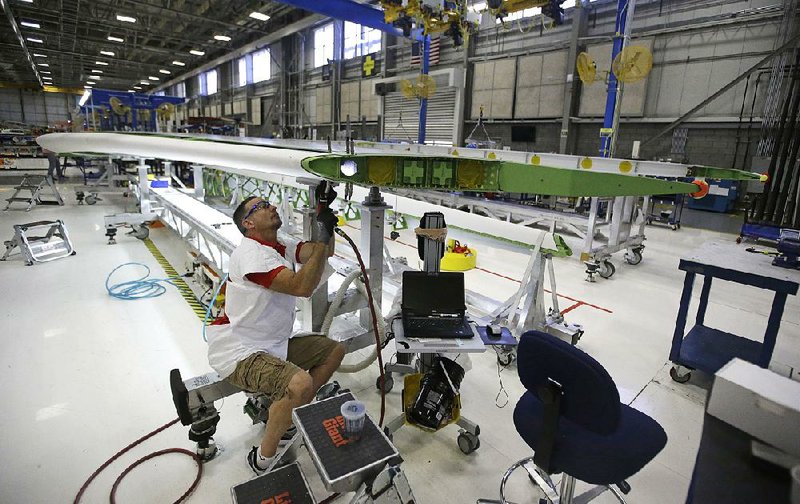WASHINGTON -- Applications for unemployment benefits rose last week, but Americans are seeking aid at historically low levels consistent with a healthy job market.
The Labor Department said Thursday that weekly applications for unemployment aid rose 10,000 to a seasonally adjusted 277,000. The four-week average, a less volatile figure, declined to 270,750.
Applications are a proxy for layoffs. The low level of applications indicates that companies trust that the U.S. economy will continue to expand and possibly will increase hiring. The report indicates that employers have yet to be frightened by a slowing of China's economy and sell-offs in the U.S. stock market.
"Filings at this level are incredibly low by historical standards," said Stephen Stanley, chief economist at Amherst Pierpont Securities. "In fact, there has not been a single weekly reading above 300,000 since February."
There are 2.19 million Americans collecting unemployment aid, the smallest total since November 2000.
Joblessness claims averaging less than 300,000 a week have corresponded with net monthly job gains of roughly 200,000.
The government today will issue its official jobs report for September. Economists forecast that report will show that employers added 206,000 jobs, and that the unemployment rate held at 5.1 percent for the second straight month.
Employers have added an average of 221,000 jobs a month in the prior three months, a solid pace that drove the unemployment rate to a seven-year low.
A private survey by payroll processor ADP said Wednesday that employers added 200,000 jobs last month.
The job growth has steadied the economy as global pressures mount. Oil prices have remained below $50 a barrel amid weak demand from China and much of Europe. The stronger dollar has crimped exports, as U.S. goods have become more expensive for foreign buyers.
But the domestic economy has been insulated from much of this turmoil. The steady pace of hiring has contributed to rising consumer confidence and has fueled stronger home sales and more residential construction this year. Developers have broken ground on 11 percent more homes in the first eight months of this year than at the same point in 2014.
U.S. manufacturers expanded at their slowest pace in two years last month, held back by faltering global growth and cutbacks in oil and gas drilling.
The Institute for Supply Management said Thursday that its index of factory activity fell sharply to 50.2 in September from 51.1 in August. That is the lowest level since May 2013. Any reading above 50 indicates expansion.
Manufacturing is "clearly the weakest part of the economy," said Jim O'Sullivan, chief U.S. economist at High Frequency Economics Ltd in Valhalla, N.Y. It's "highly exposed to foreign demand, and exports are declining."
New orders and production both fell sharply and a measure of hiring also declined, according to the institute, a trade group of purchasing managers. All three measures still barely remained in expansion territory.
U.S. manufacturers are getting hit by the slower growth in China and a stronger dollar. Besides making U.S. goods more expensive overseas, the 15 percent rise in the dollar's value in the past year has made imports cheaper compared with U.S.-made goods. Oil and gas drillers are also cutting back on their orders for steel pipe and other equipment because of low oil prices.
The report "is yet another illustration of the devastating impact that the strong dollar and weak foreign demand is having on the battered factory sector," Steve Murphy, an economist at Capital Economics, said. "Things might well get even worse before they begin to get better. Nevertheless, the ... incoming data on the rest of the economy are still incredibly upbeat."
Spending on U.S. construction projects rose in August to the highest point in more than seven years, fueled by home building and government projects.
Construction spending in August increased 0.7 percent from July, when it had risen 0.4 percent, the Commerce Department said Thursday. It rose to a seasonally adjusted annual rate of $1.09 trillion, the highest level since May 2008.
The latest result suggests that businesses remain confident enough in the economy to expand. Construction activity is expected to provide solid support for the overall economy for the rest of the year.
The gains were led by a 1.3 percent increase in home building and a 0.5 percent rise in government construction projects.
Private nonresidential construction also advanced, but by a more modest 0.2 percent. Two key areas -- office building and the category that covers shopping centers -- both declined.
The 1.3 percent rise in home construction reflected a 4.8 percent surge in apartment construction and a more modest 0.7 percent rise in construction of single-family homes.
Information for this article was contributed by Josh Boak, Christopher S. Rugaber and Martin Crutsinger of The Associated Press and by Victoria Stilwell of Bloomberg News.
Business on 10/02/2015

